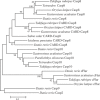Caspases: evolutionary aspects of their functions in vertebrates
- PMID: 20735596
- PMCID: PMC2779465
- DOI: 10.1111/j.1095-8649.2009.02184.x
Caspases: evolutionary aspects of their functions in vertebrates
Abstract
Caspases (cysteine-dependent aspartyl-specific protease) belong to a family of cysteine proteases that mediate proteolytic events indispensable for biological phenomena such as cell death and inflammation. The first caspase was identified as an executioner of apoptotic cell death in the worm Caenorhabditis elegans. Additionally, a large number of caspases have been identified in various animals from sponges to vertebrates. Caspases are thought to play a pivotal role in apoptosis as an evolutionarily conserved function; however, the number of caspases that can be identified is distinct for each species. This indicates that species-specific functions or diversification of physiological roles has been cultivated through caspase evolution. Furthermore, recent studies suggest that caspases are also involved in inflammation and cellular differentiation in mammals. This review highlights vertebrate caspases in their universal and divergent functions and provides insight into the physiological roles of these molecules in animals.
Figures





Similar articles
-
Caspases - an update.Comp Biochem Physiol B Biochem Mol Biol. 2008 Sep;151(1):10-27. doi: 10.1016/j.cbpb.2008.05.010. Epub 2008 Jul 3. Comp Biochem Physiol B Biochem Mol Biol. 2008. PMID: 18602321 Review.
-
Caspases in cell survival, proliferation and differentiation.Cell Death Differ. 2007 Jan;14(1):44-55. doi: 10.1038/sj.cdd.4402047. Epub 2006 Oct 20. Cell Death Differ. 2007. PMID: 17053807 Review.
-
Caspase function in programmed cell death.Cell Death Differ. 2007 Jan;14(1):32-43. doi: 10.1038/sj.cdd.4402060. Epub 2006 Nov 3. Cell Death Differ. 2007. PMID: 17082813 Review.
-
Caspases playing in the field of neuroinflammation: old and new players.Dev Neurosci. 2013;35(2-3):88-101. doi: 10.1159/000346155. Epub 2013 Feb 22. Dev Neurosci. 2013. PMID: 23445938 Review.
-
The role of caspases as executioners of apoptosis.Biochem Soc Trans. 2022 Feb 28;50(1):33-45. doi: 10.1042/BST20210751. Biochem Soc Trans. 2022. PMID: 34940803
Cited by
-
Caspase-14-like Proteases: An Epidermal Caspase and Its Evolutionarily Ancient Relatives.Biomolecules. 2025 Jun 22;15(7):913. doi: 10.3390/biom15070913. Biomolecules. 2025. PMID: 40723785 Free PMC article. Review.
-
Dependence of human cell survival and proliferation on the CASP3 prodomain.Cell Death Discov. 2024 Feb 6;10(1):63. doi: 10.1038/s41420-024-01826-6. Cell Death Discov. 2024. PMID: 38321033 Free PMC article.
-
Caspases from scleractinian coral show unique regulatory features.J Biol Chem. 2020 Oct 23;295(43):14578-14591. doi: 10.1074/jbc.RA120.014345. Epub 2020 Aug 11. J Biol Chem. 2020. PMID: 32788218 Free PMC article.
-
Conservation of structure and function in vertebrate c-FLIP proteins despite rapid evolutionary change.Biochem Biophys Rep. 2015 Aug 7;3:175-189. doi: 10.1016/j.bbrep.2015.08.005. eCollection 2015 Sep. Biochem Biophys Rep. 2015. PMID: 29124180 Free PMC article.
-
Inositol monophosphatase 1 (IMPA1) mutation in intellectual disability patients impairs neurogenesis but not gliogenesis.Mol Psychiatry. 2021 Jul;26(7):3558-3571. doi: 10.1038/s41380-020-00862-9. Epub 2020 Aug 24. Mol Psychiatry. 2021. PMID: 32839513
References
-
- Abraham MC, Shaham S. Death without caspases, caspases without death. Trends in Cell Biology. 2004;14:184–193. - PubMed
-
- Aggarwal BB. Signalling pathways of the TNF superfamily: a double-edged sword. Nature Reviews Immunology. 2003;3:745–756. - PubMed
-
- Ahmad M, Srinivasula SM, Hegde R, Mukattash R, Fernandes-Alnemri T, Alnemri ES. Identification and characterization of murine caspase-14, a new member of the caspase family. Cancer Research. 1998;58:5201–5205. - PubMed
-
- Ashkenazi A, Dixit VM. Death receptors: signaling and modulation. Science. 1998;281:1305–1308. - PubMed
Publication types
MeSH terms
Substances
LinkOut - more resources
Full Text Sources
Research Materials
